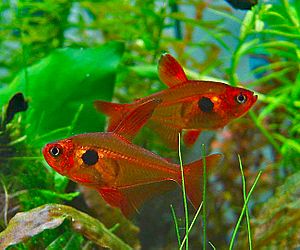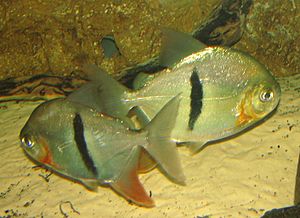Characids facts for kids
Quick facts for kids Characids |
|
|---|---|
 |
|
| Red phantom tetras (Hyphessobrycon sweglesi) | |
| Scientific classification |
|
| Kingdom: | Animalia |
| Phylum: | Chordata |
| Class: | Actinopterygii |
| Order: | Characiformes |
| Suborder: | Characoidei |
| Family: | Characidae Latreille, 1825 |
Characidae, also known as characids or characins, is a large family of freshwater fish. These fish live in warm areas, from the subtropical to tropical parts of the world. They belong to a bigger group of fish called Characiformes.
The name "characins" is older, but scientists today often use "characids". This is because it helps show that most fish in this group are closely related. This family has changed a lot over time as scientists learn more about fish.
Some well-known fish in this family are the tetras. This includes popular aquarium fish like the neon tetra and the cave tetra. Many characids are important as food for people, and many are also popular aquarium fish.
These fish come in many sizes. Many are smaller than 3 cm (1.2 in). One of the smallest, Hyphessobrycon roseus, grows to only about 1.9 cm long.
Characids live in many different places and habitats. They are originally from the Americas, found from southwestern Texas and Mexico all the way through Central and South America. Many of these fish live in rivers. However, some, like the blind cave tetra, can even be found living in caves!
How Scientists Group These Fish
Scientists are always learning more about how different types of fish are related. Because of this, the Characidae family has changed a lot over the years. Many fish that used to be part of this family have now been moved to their own separate families.
For example, the pencilfishes (from the genus Nannostomus) are now in the Lebiasinidae family. The predatory fish like Hoplias and Hoplerythrinus are now in the Erythrinidae family. Even the sabre-toothed fish from the genus Hydrolycus have been moved to the Cynodontidae family.

One of the most famous examples is the piranhas. They were first thought to be part of the Characidae family. But now, many scientists believe they should be in their own family called Serrasalmidae. This idea is becoming more popular among fish scientists.
Because scientists are still studying how all these fish are related, more changes might happen in the future. This means some fish you know as characids might one day be moved to a different family!
Common Characid Fish
Many fish in the Characidae family are well-known. Some of the largest groups of species within this family are found in the genera Hyphessobrycon, Astyanax, Hemigrammus, Moenkhausia, and Bryconamericus. These groups have many different kinds of fish that scientists are still studying.
See also
 In Spanish: Characidae para niños
In Spanish: Characidae para niños
Images for kids
-
Emperor tetra (Nematobrycon palmeri)








